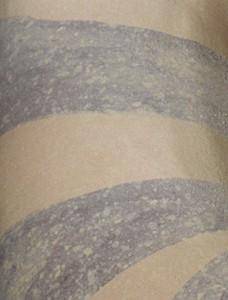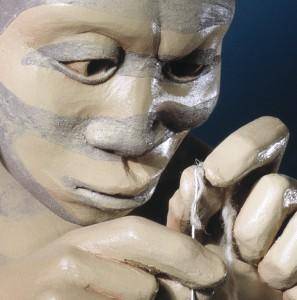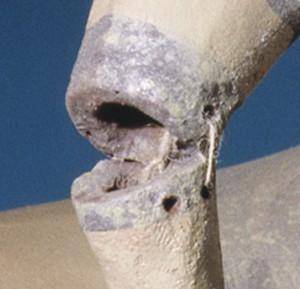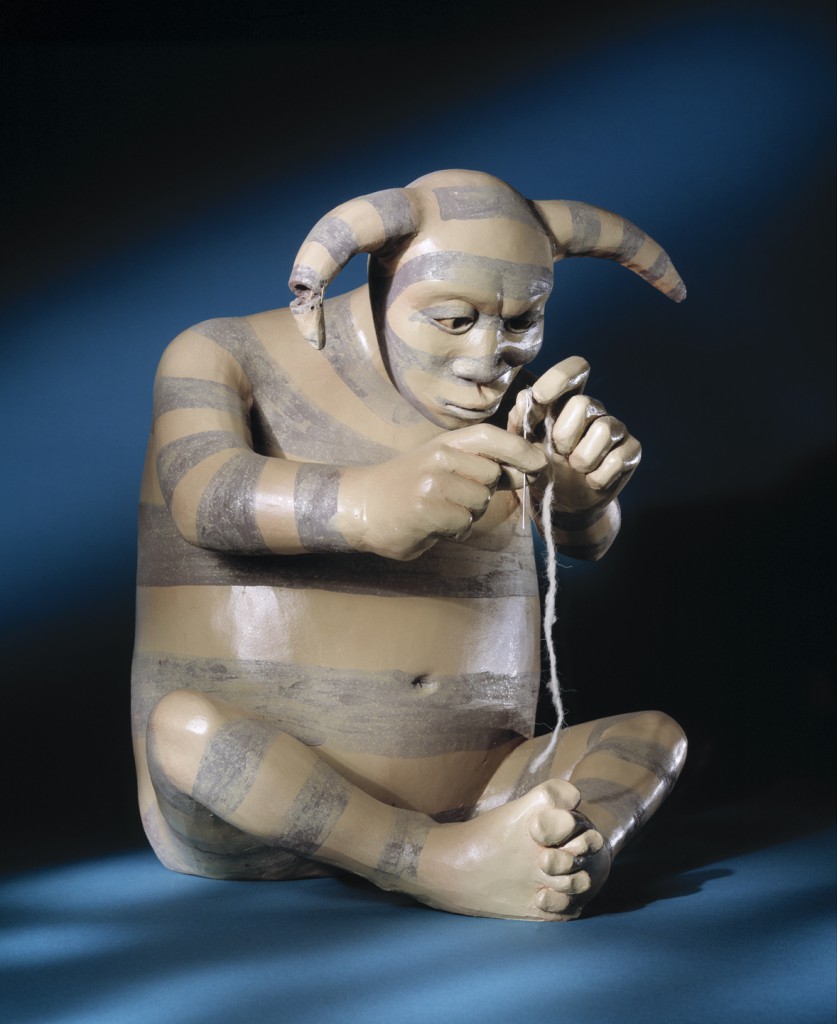Students will work collaboratively to construct and defend a written argument that addresses how to use evidence from history to maintain society and avoid repeating an environmental or other concern that started from something seemingly insignificant.
Students will be able to:
- discuss the ways in which human interaction with the environment has been a critical issue throughout history and today;
- research historical evidence that supports a theory;
- debate how a society decides what is important in history; and
- develop a plan to use history to understand the feasibility of mending a problem area.
Lesson
- Show students the image of The Things I Have to Do to Maintain Myself. Ask them to describe what they see, prompting them with the following questions: What do you think the sculpture represents? Does it remind you of anything you have seen before? Be sure to point out that the person is mending something that is broken. Explain that this is a sculpture made of clay by Roxanne Swentzell, a member of the Santa Clara Pueblo, which is located in New Mexico. It portrays an image of a kosha. According to Pueblo belief systems, a kosha is kind of like a clown who teaches humans lessons by imitating them. Swentzell says that this artwork is meant to reference the idea that humans are in a constant state of development. An individual makes choices as he/she creates him/herself. Swentzell is also asking us to consider the importance of seemingly mundane acts. “I like to make the mundane significant, because that’s the way we go throughout days. This piece is about all the little things we do to make things possible.”
- The complex interrelationship between the past and present is evident when solving issues over time. In many cases, what seem like little things done over and over again lead up to a problem that needs mending. For example, human interaction with the environment is a very important issue to Swentzell. The “Who Made It” section of the About the Art section tells us that through her interests in nature and preserving the Earth, Swentzell founded the Flowering Tree Permaculture Institute, “a research and education organization that relates to permaculture…a way of looking at the world based on the laws of nature.”
- The way humans interact with the environment has been a critical issue throughout history and continues to be a factor in pollution, climate change, and resource management. Examples include pollution during the Industrial Revolution, or land management issues that led to the Dust Bowl. As a class, list other local, state, or worldwide environmental issues or concerns where little things have built up to something that needed mending.
- The Pueblo cultural understanding of the kosha says that they teach by imitating human behavior. The idea is that when humans see what they are really doing they will understand that it might be wrong. How can we learn by studying previous events in human history? How can the study of history help us maintain our society, similar to the way the kosha is maintaining itself? Ask students to work in collaborative groups to identify a problem and construct and defend a written argument for solving the problem using relevant historical sources as evidence.
Materials
- About the Art section on The Things I Have to Do to Maintain Myself (included with the lesson plan) or student access to Creativity Resource online
- Color copies of The Things I Have to Do to Maintain Myself, or the ability to project the image onto a wall or screen
- A United States map for the entire class to see
- Access to the internet or other sources of historical information
- Paper
- Writing implements
- Access to a word processor
Standards
- Social Studies
- History
- Geography
- Evaluate and analyze sources using historical method of inquiry and defend their conclusions
- Understand the concept that the power of ideas is significant throughout history
- Analyze the concepts of continuity and change and effect
- Analyze the concept of complexity, unity and diversity
- Become familiar with people in the world who are interconnected by geography
- Become familiar with United States geography
- Understand geographic variables and how they affect people
- Visual Arts
- Relate and Connect to Transfer
- Language Arts
- Research and Reasoning
- Writing and Composition
- Reading for All Purposes
- Collaboration
- Critical Thinking & Reasoning
- Information Literacy
- Self-Direction

The Things I Have To Do To Maintain Myself
Height: 15.5 in. Width: 13 in. Depth: 15 in.
Funds from Polly and Mark Addison, 1994.540
Photograph © Denver Art Museum 2009. All Rights Reserved.
Roxanne Swentzell was born in Taos, New Mexico in 1962. Her mother was a potter, writer, and scholar from Santa Clara Pueblo, and her father was a New Jersey native of German descent who was a philosophy professor in Santa Fe. Growing up in Santa Fe, in a household that was filled with clay and artwork, Roxanne took to art-making at an early age. As a child, she struggled to express herself verbally. In order to let others know how she was feeling, she would sculpt small figures that represented her emotions.
Roxanne attributes much of her success to guidance from her family, particularly her mother, Rina, and her uncle, Michael Naranjo, a blind sculptor. From 1978-1980, before graduating high school, she attended the Institute of American Indian Arts.
Today, she spends much of her time at Tower Studio, twelve miles north of Santa Fe. Continuing her interests in nature and preserving the earth, Swentzell founded the Flowering Tree Permaculture Institute, “a research and education organization that relates to permaculture…a way of looking at the world based on the laws of nature.”
Swentzell believes that it is extremely important for her work to have a direct connection with reality. Her art must be a full expression of herself and her experiences and observations of life. She says, “I learned to listen to myself and not be so influenced by what other people wanted me to make. I am going to present the world through my eyes—and not as somebody told me I was supposed to.” She also aims to communicate with all people through her artwork—both Native and non-Native—about the things we share as humans. “With my sculptures I try to reach people’s emotions so they can remember themselves,” says Swentzell.
This sculpture is a representation of a clown, called a kosha in Tewa [TAY-wah], the language of Santa Clara Pueblo. In the Pueblo creation story, the kosha were the first to emerge onto the surface of the earth, climbing up from the underworld and out of the womb of Mother Earth. As they surfaced, each was facing one of the four cardinal directions. The people of the earth followed, dispersing to all parts of the world and becoming the different races. Kosha continue to play a part in Santa Clara ceremonies and stories. One of their main roles is to teach lessons about life. Kosha teach by imitating human behaviors; it is then up to us to recognize when those behaviors are flawed.
This kosha sits deep in concentration, mending his broken ear. With this sculpture, Swentzell references the idea that humans are in a constant state of development. An individual makes choices as he/she creates him/herself. Swentzell is also asking us to consider the importance of a seemingly mundane act. “I like to make the mundane significant, because that’s the way we go throughout days. This piece is about all the little things we do to make things possible. It’s an appreciation of something that’s not always acknowledged,” says Swentzell.
Details

Stripes
The black and white stripes on the body of the kosha represent balance, one of the important life lessons that are taught by kosha.

Concentration
The kosha is deep in concentration. Notice how he carefully threads the needle with an extra-thick piece of yarn. His eyes are focused, his lips are pursed, and even his toes are curled tightly together.

Materials
Swentzell makes her sculptures out of clay, using the techniques of a potter. Unlike other potters in her family, she uses purchased clay, in part due to the large amounts that she uses. She uses coils to create the body and makes cuts where she will add limbs, which are made with coils as well. The body and limbs are hollow, while the toes and fingers are solid. She sculpts the face. The figure must dry for about two weeks before it is ready to be fired in a kiln.
Funding for object education resources provided by a grant from the Morgridge Family Foundation. Additional funding provided by the William Randolph Hearst Endowment for Education Programs, and Xcel Energy Foundation. We thank our colleagues at the University of Denver Morgridge College of Education.
The images on this page are intended for classroom use only and may not be reproduced for other reasons without the permission of the Denver Art Museum. This object may not currently be on display at the museum.







